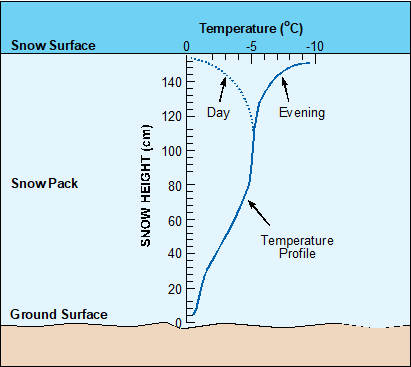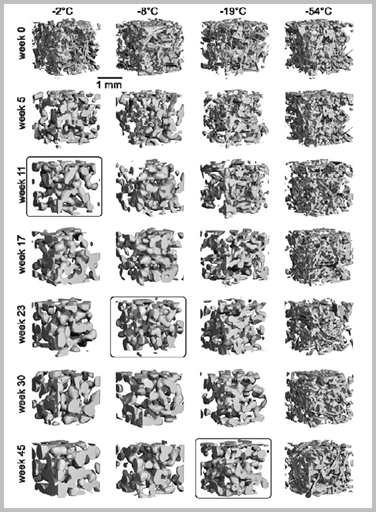Download PDF
Download page Snow Properties.
Snow Properties
The primary physical properties of a snowpack important to hydrology are three properties that can vary from point to point: Snow Water Equivalent (SWE), snowpack temperature, as represented by its Cold Content, and Liquid Water Content; and one spatial property: the Snow Covered Area (SCA). The point properties are applicable at a specific location at a specific time, and represent the entire single layer of the snowpack at that location. These properties will vary from location to location throughout a watershed and with time. The primary spatial property of the snow cover for hydrology is the SCA. SCA describes the area of a watershed that is snow covered. SCA often changes with time, especially during periods of snowmelt.
Snow Covered Area (SCA)
The Snow Covered Area (SCA, pronounced “Ska”) is the portion of a given area covered by snow. In theory, the given area can be an entire watershed, a subbasin, an elevation band, a grid cell, or any other arbitrarily designated area. Generally SCA is given in terms of area, or as a fraction of the designated area.
In mountainous watersheds SCA is usually closely associated with elevation. In watersheds with low topographic relief, SCA reflects the paths of snow storms that have crossed the watershed. Determination of the SCA of a watershed may be easy or very difficult, depending on the size, accessibility, remoteness, topographic relief, and the extent of installed instrumentation. In recent decades, the development of optical and passive microwave satellite sensors has provided an extensive suite of instruments for accurately mapping snow.
Snow Water Equivalent (SWE)
The Snow Water Equivalent, (SWE, pronounced “sweeee”) is the height of water if a snow cover is completely melted, on a corresponding horizontal surface area. The continuity equation equating the mass of liquid water in SWE with the mass snow in the snowpack is
| \rho_wSWE = \overline{\rho}_SD |
where ρw = the density of water; SWE = the snow water equivalent; \overline{\rho}_S = the depth averaged snow density; and D = the snow depth. Snow depth denotes the total height of the snowpack, i.e., the vertical distance from the ground to the snow surface. Unless otherwise specified, SWE and snow depth are related to a single location at a given time. Snow density, i.e., mass per unit volume, is normally determined by weighing snow of a known volume. Theoretically, total snow density encompasses all constituents of the snowpack - ice, liquid water, vapor, and air. In practice, only the ice and liquid water are included in estimates of SWE as the air and water vapor make only a negligible contribution to the density. Rearranging equation
| $S W E=\frac{\bar{\rho}_{s}}{\rho_{w}} D$ |
As shown in equation , if D and \overline{\rho}_S are both known, then SWE can be estimated (as the density of water is always known). It is also clear that D alone is not sufficient to estimate SWE unless some estimate of snow density can be made. In fact, snow depth is a parameter that is of little use in snowmelt hydrology, except when used to estimate SWE.
Snow Type | Density (kg/m3) | Snow Depth for One Inch Water |
|---|---|---|
Wild Snow | 10 to 30 | 33” to 98” |
Ordinary new snow immediately after falling in still air | 50 to 65 | 20” to 15” |
Settling Snow | 70 to 90 | 11” to 14” |
Average wind-toughened snow | 280 | 3.5” |
Hard wind slab | 350 | 2.8” |
Snowpack Temperature/Cold Content
The snowpack temperature is controlled by heat transfer through the snow surface to the atmosphere, heat transfer through the snowpack base to the ground below, and the temperature of the falling snow deposited in the snowpack. The trend of the snowpack temperature is to follow the air temperature as long as the air temperature is below 0°C (32°F). The actual vertical temperature profile through the snowpack will depend on the snowpack surface temperature, the base temperature, the snowpack depth, and the thermal conductivity of the snow in the pack.
Phase Change of Snow
While 0°C (32°F) is often called the melting temperature of ice, ice happily survives at 0°C (32°F). It is only when heat is transferred into ice which is at 0°C (32°F) that melting, the phase change from solid ice to liquid water, occurs. Similarly, liquid water also happily survives at 0°C (32°F). It is only when heat is transferred away from liquid water which is at 0°C (32°F) that freezing, the phase change from liquid water to solid ice, occurs. If ice and liquid water are coexisting in a given volume, their masses are not changing with time, and there is no heat transfer into or out of the volume, then their temperature must be 0°C (32°F).
In many cases, during the accumulation phase of the winter season, a difference in temperature exists between the top surface and the base of the snowpack. This temperature gradient may be large or small depending on the conditions. Small temperature gradients occur with deep snow and moderately cold temperatures. Large gradients tend to occur in shallow snowpacks with very cold air temperatures.

Large gradients can drive heat and water vapor from the warmer portions of the snowpack (generally the base) to the colder portions (generally the surface). This heat and mass flux can lead to rapid metamorphism, causing changes in the ice crystal size and shape.

The snowpack temperature cannot be greater than 0°C (32°F), the temperature at which ice and water coexist. If the snowpack temperature is less than 0°C (32°F) then liquid water cannot exist for any length of time in the snowpack. If the snowpack temperature is at 0°C (32°F), then liquid water can exist in the snowpack. The snowpack is at 0°C (32°F) and isothermal, with uniform temperature from surface to base (zero temperature gradient), during the active melt period.
The concept of “Cold Content” grew directly out of attempts to predict snowmelt using the Temperature Index approach. Snowmelt cannot occur unless the snowpack temperature is at 0°C (32°F). Cold content is the heat necessary to warm the snowpack up to 0°C (32°F) in terms of the amount of ice this heat would melt.
The heat required per unit area to raise temperature of the snowpack to 32°F (0°C), Hc_heat, is
| $H_{c_{\text {_heat }}}=\bar{\rho}_{s} C_{p {\text { _ice }}} D \Delta T$ |
where \overline{\rho_s}= the depth averaged snow density; Cp_ice = the heat capacity of ice; D = the snow depth; and ΔT = the temperature below 0°C (32°F).
Parameter | Definition | SI | Customary |
|---|---|---|---|
Cp ice | Heat Capacity ice | 2114 J/kg °C | 0.505 Btu/lb °F |
λ | latent heat of fusion of water | 333.4 k J/Kg | 143.3 Btu/lb |
ρw | Density of water (0°C- 32°F) | 999.87 kg/m3 | 62.42 lb/ft3 |
In practice, the flow of heat is not estimated during snowmelt modeling when using the Temperature Index approach. Rather (as will be shown in the section on modeling below), the snowpack temperature is more conveniently described by expressing the Cold Content as the negative of the depth of frozen water that Hc_heat would melt.
| $C_{c}=-\frac{H_{c_{\text {_heat }}}}{\rho_{w} \lambda}=-\frac{\bar{\rho}_{s}}{\rho_{w}} D \frac{C_{p {\text{ _ice}}} \Delta T}{\lambda}$ |
where λ = the latent heat of fusion of water; and Cc = the Cold Content in units of negative inches (or cm).
Liquid Water Content
Liquid Water Content (LWC) describes the amount of liquid water contained in the snowpack. Liquid water in the snowpack results from ice melting or by rain falling on the snow surface and can only permanently exist in the snowpack when the snowpack temperature is at 0°C (32°F). Another, and equivalent, way of stating this is: liquid water can exist in the snowpack only if the Cold Content is zero.
There is a limit to the amount of liquid water that a snowpack can hold, described by the percentage, LWCmax%, of the SWE. Further liquid water added to the snowpack once the percentage of LWC in the snowpack has reached LWCmax% leads to the downward vertical movement of the liquid water through the snowpack. Once the liquid water reaches the base of the snowpack it becomes snowmelt runoff. Another term for snowmelt runoff is Liquid Water at the Soil Surface (LWASS).
A “ripe” snowpack has Cc = 0; and the percentage of LWC in the snowpack is LWCmax%. Any heat added to a ripe snowpack will result in snowmelt runoff.
The downward vertical movement of liquid water through the snowpack is an interesting physical process. In most cases, the snowpack is not saturated with water. Air can move freely throughout the snowpack and the air pressure is uniform throughout. The effects of capillarity are generally regarded as negligibly small compared to the effects of gravity, and the inertial forces are small compared to viscous forces. An analysis of flow under these conditions balances the downward pull of gravity on the water and the fluid viscous forces. The movement of liquid water occurs at very low Reynolds number and can be described as creeping or Stokes flow. The result is a simplified form of Darcy’s equation. The effective permeability of the snowpack - a key parameter of Darcy’s equation - has only been roughly measured. Observations suggest that the permeability is proportional to the third power of the effective saturation. This strong nonlinearity greatly complicates the solution of the flow equation.
A number of factors can impact the movement of liquid water through the snowpack, including non-uniform temperatures with depth, non-homogeneity of the crystal and void sizes, formation of ice lenses, etc. Nonetheless, once the liquid water has reached the base of the snowpack and snowmelt runoff has commenced, further additions of liquid water move through the snowpack relatively rapidly. So rapidly, in fact, that any delay in the appearance of snowmelt runoff caused by the vertical movement of water through the snowpack is not considered hydrologically significant. As a result, once the models determine that the conditions are appropriate for snowmelt runoff (Cc = 0 and LWC = LWCmax), snowmelt runoff will occur without delay.
Term | Description | Range % | Mean % |
Dry | Usually Ts is below 0°C, but dry snow can occur at any temperature up to 0°C. Disaggregated snow grains have little tendency to adhere to each other when pressed together, as in making a snowball. | 0 | 0 |
moist | Ts = 0°C. The water is not visible even at 10x magnification. When lightly crushed, the snow has a distinct tendency to stick together. | 0–3 | 1.5 |
wet | Ts = 0°C. The water can be recognized at 10x magnification by its meniscus between adjacent snow grains, but water cannot be pressed out by moderately squeezing the snow in the hands (pendular regime). | 3–8 | 5.5 |
very wet | Ts = 0°C. The water can be pressed out by moderately squeezing the snow in the hands, but an appreciable amount of air is confined within the pores (funicular regime). | 8–15 | 11.5 |
Soaked or slush | Ts = 0°C. The snow is soaked with water and contains a volume fraction of air from 20 to 40% (funicular regime). | >15 | >15 |
Pendular regime (of water) The condition of low liquid water content where a continuous air space as well as discontinuous volumes of water coexist in a snowpack, i.e., air-ice, water-ice, and air-liquid interfaces are all found. Grain-to-grain bonds give strength. The volume fraction of free water does not exceed 8 %.
Funicular regime (of water) The condition of high liquid water content where liquid exists in continuous paths covering the ice structure; grain-to-grain bonds are weak. The volume fraction of free water exceeds 8 %.